

Indonesia prepares for Isis backlash from returning jihadis. China’s Not So Secret War on Religion. The week starting May 18 marked a new low for religious groups in China.

That Sunday, authorities quietly removed or destroyed crosses at 50 churches in Zhejiang in what appeared to be a widening campaign against Christianity in this prosperous eastern province. No mention of the campaign appeared in Chinese media. Four days later, Islamic separatists plowed into the crowded main market in Urumqi, at the opposite end of the country in Xinjiang province, throwing explosives at innocent shoppers and killing 43 people including the five assailants themselves. The next day, Chinese authorities announced a one-year crackdown in restive Xinjiang using “extremely tough measures and extraordinary methods” following a spate of attacks including this second incident in the provincial capital in less than a month. Severe punishments have followed in Xinjiang thick and fast.
Alim Seytof, director of the Washington D.C. The Chinese Communist Party appears concerned. Should China Fear Islamic Insurgency? China Is Losing War on Terror. All evidence suggests that China is losing its new war on Uyghur terrorism.
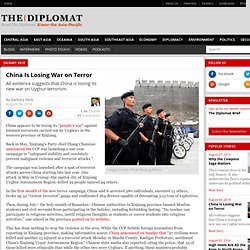
China appears to be losing its “people’s war” against Islamist terrorism carried out by Uyghurs in the western province of Xinjiang. Back in May, Xinjiang’s Party chief Zhang Chunxian announced the CCP was launching a one-year campaign to “safeguard stability and resolutely prevent malignant violence and terrorist attacks.” The campaign was launched after a spat of terrorist attacks across China starting late last year. Connecting the Dots on Buddhist Fundamentalism. Buddhist fundamentalism seems to be fast spreading its tentacles in Sri Lanka, Myanmar and Thailand, as newspapers report violent attacks on religious minorities and shrill demands to ban “blasphemy” against Buddhism.
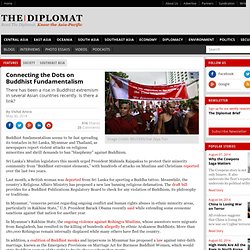
Sri Lanka’s Muslim legislators this month urged President Mahinda Rajapaksa to protect their minority community from “Buddhist extremist elements,” with hundreds of attacks on Muslims and Christians reported over the last two years. Last month, a British woman was deported from Sri Lanka for sporting a Buddha tattoo. Meanwhile, the country’s Religious Affairs Ministry has proposed a new law banning religious defamation. Korea’s Multicultural Future? With a growing number of migrant workers, can South Korea adapt to a new national identity not based on ethnicity?
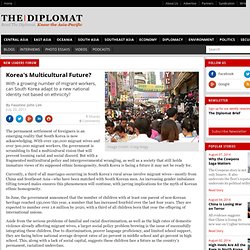
By Faustino John Lim for The Diplomat July 20, 2011. Korea’s Multicultural Growing Pains. A recent incident involving Little Psy highlights South Korea’s struggles with its growing racial diversity.
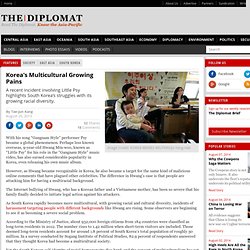
By Tae-jun Kang for The Diplomat August 20, 2013. Empire and the Rising Violence in Xinjiang. The Chinese Communist Party (CCP) is failing to deliver on its promises to quell violence in Xinjiang.
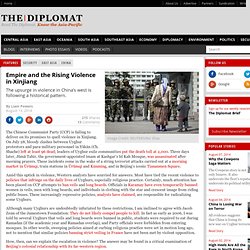
On July 28, bloody clashes between Uyghur protestors and para-military personnel in Yäkän (Ch. Shache) left at least 96 dead; leaders of Uyghur exile communities put the death toll at 2,000. South Korea Redefines Multiculturalism. Few countries take multiculturalism as seriously as Korea does.

While most countries have vague and ambiguous multicultural policies consisting of either forcing immigrants to assimilate to the local culture or allowing immigrants to integrate while keeping their traditions, Korea has come up with a new concept: tamunhwa. Tamunhwa means multiculturalism in Korean, and the basic idea is for Koreans to learn as much as they can about immigrants’ original culture while setting up as many cultural immersion programs as possible for immigrants. With foreign residents now accounting for nearly 3 percent of the population of a country that long defined itself as homogenous, Koreans are taking multiculturalism seriously. Immigration policies in Korea are strict. Are Ethnic Tensions on the Rise in China? Ethnic Struggles Are Central to Burma’s Future. Get_file. Promising Signs in Southeast Asia. The United States may have simply kicked the fiscal cliff—or at least part of it—further down the road, and the eurozone looks no closer to solving its economic problems.
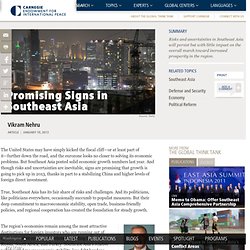
But Southeast Asia posted solid economic growth numbers last year. And though risks and uncertainties are inevitable, signs are promising that growth is going to pick up in 2013, thanks in part to a stabilizing China and higher levels of foreign direct investment. True, Southeast Asia has its fair share of risks and challenges. And its politicians, like politicians everywhere, occasionally succumb to populist measures.
But their deep commitment to macroeconomic stability, open trade, business-friendly policies, and regional cooperation has created the foundation for steady growth. The region’s economies remain among the most attractive destinations for foreign investors who are running out of options in other emerging markets—including India, Brazil, Russia, South Africa, and Turkey. Race and religion in South-East Asia: The plural society and its enemies. Croissant Trinn Cultural Conflicts.pdf. Deepening democracy in South Asia: Off square one. Asia: A new miracle for tigers and dragons. The dynamics of Asia today are a complex of relations among three emerging communities—East Asia, South-East Asia and South Asia.

How these three communities relate to one another will be the great challenge facing Asian leaders in 2008 and beyond. Over a decade ago the world admired South-East Asia's tiger economies for their market-friendly and export-oriented policies, providing years of spectacular growth. Today, ASEAN's leaders need a new economic miracle to meet the challenges posed by a resurgent China and India. China's pre-eminent status will be consolidated after the 2008 Beijing Olympics. Buddhism v Islam in Asia: Fears of a new religious strife. Why Myanmar Matters: Ensuring the Future of the Liberal International Order in East Asia — The Tokyo Foundation. Myanmar has become a new frontier for cooperation among Japan, the United States, and Europe under President Thein Sein’s initiative for democratization and market reform.

Senior Fellow Tsuneo Watanabe notes that Myanmar’s trajectory will have an impact on the future regional order, testing whether Chinese aspirations for national rejuvenation can coexist with the interests of neighboring countries and the larger international community. The Japanese government has demonstrated new thinking, recently collaborating with a domestic NGO to facilitate the process of ethnic reconciliation in the country. The global policy community sees East Asia as a prosperous and stable region, an engine of economic growth, and the locus of business opportunities.
The region’s development began with Japan’s “economic miracle” of the 1960s and 1970s, which was followed by rapid growth in South Korea, Taiwan, Hong Kong, and Singapore in the 1980s, China in the 1990s, and India in the 2000s. The Cities Papers » Ethnic Conflict in Urban Asia. An empirical regularity has time and again confronted scholars of ethnic conflict. Despite ethnic diversity, some places -- nations, regions, towns, villages -- remain peaceful, whereas others with the same diversity experience frequent outbursts of violence.
Similarly, some multiethnic societies, after maintaining a long record of peace, explode all of a sudden. Scholars have sought to explain these variations across time and space for some time now. On Hindu-Muslim conflict, mainly confined to urban India, my book, published some years ago, dealt with variation across space. A project since then has sought to understand whether the Indian argument is portable to non-Indian settings. Hindu-Muslim Relations and Urban India To understand variations across space on Hindu-Muslim violence in India, my book went through all reported Hindu-Muslim riots in the country between1950-95. In other words, India's Hindu-Muslim violence was city‑specific. Discovering the Role of Civil Society.